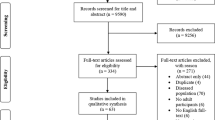Summary
Five men performed submaximal isometric, concentric or eccentric contractions until exhaustion with the left arm elbow flexors at respectively 50%, 40% and 40% of the prefatigued maximal voluntary contraction force (MVC). Subsequently, and at regular intervals, the surface electromyogram (EMG) during 30-s isometric test contractions at 40% of the prefatigued MVC and the muscle performance parameters (MVC and the endurance time of an isometric endurance test at 40% prefatigued MVC) were recorded. Large differences in the surface EMG response were found after isometric or concentric exercise on the one hand and eccentric exercise on the other. Eccentric exercise evoked in two of the three EMG parameters [the EMG amplitude (root mean square) and the rate of shift of the EMG mean power frequency (MPF)] the greatest (P<0.001) and longest lasting (up to 7 days) response. The EMG response after isometric or concentric exercise was smaller and of shorter duration (1–2 days). The third EMG parameter, the initial MPF, had already returned to its prefatigued value at the time of the first measurement, 0.75 h after exercise. The responses of EMG amplitude and of rate of MPF shift were similar to the responses observed in the muscle performance parameters (MVC and the endurance time). Complaints of muscle soreness were most frequent and severe after the eccentric contractions. Thus, eccentric exercise evoked the greatest and longest lasting response both in the surface EMG signal and in the muscle performance parameters.
Similar content being viewed by others
References
Asmussen E (1953) Positive and negative muscular work. Acta Physiol Scand 28:364–382
Asmussen E (1956) Observations on experimental muscular soreness. Acta Rheumatol Scand 2:109–116
Bigland-Ritchie B (1981) EMG/Force relations and fatigue of human voluntary contractions. Exerc Sport Sci Rev 9:75–117
Brendstrup P (1962) Late edema after muscular exercise. Arch Phys Med Rehabil 43:401–405
Edwards RHT, Hill DK, Jones DA, Merton PA (1977) Fatigue of long duration in human skeletal muscle after exercise. J Physiol 272:769–778
Friden J, Sjostrom M, Ekblom B (1981) A morphological study of delayed muscle soreness. Experientia 37:506–507
Funderburk CF, Hipskind SG, Welton RC, Lind AR (1974) Development of and recovery from fatigue induced by static effort at various tensions. J Appl Physiol 37:392–3960
Hara T (1980) Evaluation of recovery from local muscle fatigue by voluntary test contractions. J Hum Ergol 9:35–46
Hultman E, Sjoholm H (1983) Electromyogram, force and relaxation time during and after a continuous electrical stimulation of human skeletal muscle in situ. J Physiol 339:33–40
Inbar GF, Allin J, Kranz H (1987) Surface EMG spectral changes with muscle length. Med Biol Eng Comput 20:683–689
Jones DA, Newham DJ, Round JM, Tolfree SEJ (1986) Experimental human muscle damage: morphological changes in relation to other indices of damage. J Physiol 375:435–448
Jones DA, Newham DJ, Torgan C (1989) Mechanical influences on long-lasting human muscle fatigue and delayed-onset pain. J Physiol 412:415–427
Kroon GW, Naeije M (1988) Recovery following exhaustive dynamic exercise in the human biceps muscle. Eur J Appl Physiol 58:228–232
Kuorinka I (1988) Restitution of the EMG spectrum after muscular fatigue. Eur J Appl Physiol 57:311–315
Kwatny E, Thomas D, Kwatny HG (1970) An application of signal processing techniques to the study of myo-electric signals. IEEE Trans Biomed Eng 17:303–313
Lindstrom L, Magnussen R, Petersen I (1970) Muscular fatigue and action potential conduction velocity changes studied with frequency analysis of EMG signals. Electromyography 4:341–356
Lindstrom L, Kadefors R, Petersen I (1977) An electromyographic index for localized muscle fatigue. J Appl Physiol Respir Environ Exerc Physiol 43:750–754
Lippold OCJ, Redfearn JWT, Vuco J (1960) The electromyography of fatigue. Ergonomics 3:121–131
Maton B (1981) Human motor unit activity during the onset of muscle fatigue in submaximal isometric isotonic contraction. Eur J Appl Physiol 46:271–281
Mills KR, Edwards RHT (1984) Muscle fatigue in myophosphorylase deficiency: power spectra analysis of the electromyogram. Electroencephalogr Clin Neurophysiol 57:330–335
Moxham J, Edwards RHT, Aubier M, de Troyer A, Farkas G, Macklem PT, Roussos C (1982) Changes in EMG power spectrum (high-to-low ratio) with force fatigue in humans. J Appl Physiol Respir Environ Exerc Physiol 53:1094–1099
Naeije M (1984) Correlation between surface electromyograms and the susceptibility to fatigue of the human masseter muscle. Archs Oral Biol 29:865–870
Naeije M, Zorn H (1981) Changes in the power spectrum of the surface electromyogram of the masseter muscle due to local fatigue. Archs Oral Biol 26:409–421
Newham DJ (1988) The consequences of eccentric contractions and their relationship to delayed onset muscle pain. Eur J Appl Physiol 57:353–359
Newham DJ, Mills KR, Quigley BM, Edwards RHT (1983) Pain and fatigue following concentric and eccentric muscle contractions. Clin Sci 64:55–62
Okada M (1987) Effect of muscle length on surface EMG wave forms in isometric contractions. Eur J Physiol 56:482–486
Petrofsky JS, Lind AR (1980) Frequency analysis of the surface electromyogram during sustained isometric contractions. Eur J Appl Physiol 43:173–182
Sargeant AJ, Dolan P (1987) Human muscle performance following prolonged eccentric exercise. Eur J Appl Physiol 56:704–711
Vollestad NK, Sejersted OM (1988) Biochemical correlates of fatigue. Eur J Appl Physiol 57:336–347
Author information
Authors and Affiliations
Rights and permissions
About this article
Cite this article
Kroon, G.W., Naeije, M. Recovery of the human biceps electromyogram after heavy eccentric, concentric or isometric exercise. Europ. J. Appl. Physiol. 63, 444–448 (1991). https://doi.org/10.1007/BF00868076
Accepted:
Issue Date:
DOI: https://doi.org/10.1007/BF00868076




